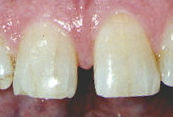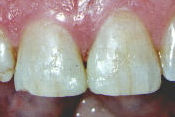Dental bonding is the process of adding tooth colored material to your teeth. This material, which is the same as the material used in tooth colored – or composite- fillings, is matched to the color of your teeth, making the transition from tooth to composite unnoticeable. This bonding can fix cracked, chipped or misshapen teeth without removing much, if any, tooth structure. Bonding is also often used to close gaps between teeth instead of going with the more expensive and longer treatment of orthodontics. In some cases, bonding can be used to whiten discolored teeth.
What are the benefits to bonding? For starters, you get your teeth looking beautiful at a fraction of the time and cost of veneers or crowns. Crowns and veneers appointments can take multiple trips to the dental office or hours of your time to complete. Bonding on the other hand is often a quick appointment, that usually ranges from 30-60 minutes. Bonding procedures typically do not require any anesthetic (getting numb) since it is for cosmetic issues and not a filling that treats a cavity. Lastly, dental bonding lasts longer than whitening when it comes to color. This is a great option for people who might have sensitivity when going through bleaching treatments.
Bonding sounds amazing! Are there any possible downsides to bonding? Of course, nothing is perfect! Bonding is not unbreakable. Bonding material used in dental offices, while sturdy, are not as strong as your natural teeth, and also not as strong as a veneer or crown. Another con to dental bonding is the fact that the bonding material is stainable. Just like with your natural teeth, consuming things like coffee, red wine, sodas, and smoking can discolor your bonding. And, unlike your natural teeth, bonding does not bleach. Meaning, if you wanted to get your teeth whiter again, your would have to get the bonding redone. Lastly, while dental bonding is strong and has a long lifespan, it is possible to need the bonding redone often due to your bite, causing chips in the bonding.
Once you have decided to get your dental bonding and it is complete, make sure you take care of it! Going to the dentist every 6 months for your routine cleanings and exams are crucial for the life of your bonding. If taken care of properly, dental bonding could last you up to 10 years. In addition to making those dental cleanings, it is best to avoid chewing on hard items such as ice, hard candy, and pen caps.
If you have any questions about dental bonding or are interesting in having bonding done, give us a call! Dr Fattahi would love to answer your questions and make your teeth as beautiful as you deserve.
Bonding is simply adding a little tooth-colored composite material to “fill in the blanks.” One of the most frequent uses of the bonding technique is to fill in a gap between front teeth.
 |
Before: A noticeable space between the front teeth. |
 |
After: Bonding fills the space, but still keeps the teeth looking natural. |


